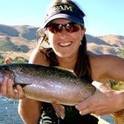
A major goal in conservation biology is to predict habitat use by animals. This goal requires the use of methods that both identify quality features of habitats for animals and measure those features across different spatial scales. Remote sensing has been used for landscape-scale analysis of habitat features to explain the spatial habitat use of large herbivores. However, studies that directly link specific parameters of habitat quality to selection by wildlife are needed at the microsite-scale before landscape-scale mapping can be validated. We used the sagebrush-pygmy rabbit and sage grouse systems to develop spectral biomarkers that can predict the quality of food on a scale that is relevant to a foraging herbivore. We hypothesized that nutritional and chemical content would differ between sagebrush plants used and not used by herbivores and that these plants would have different spectral profiles. We used paired t-test to compare the crude protein and monoterpene content of used and non-used samples and then scanned samples using a near-infrared (NIR) spectrometer to get a spectral "fingerprint" of samples. Crude protein was higher and monoterpenes were significantly lower in sagebrush shrubs that were closer to pygmy rabbit burrows compared to sagebrush that was farther from burrows, and the spectral profile of sagebrush differed between locations. In addition, dwarf sagebrush species (Artemisia. arbuscula and A. nova), which were browsed more than expected, lacked specific monoterpenes found in big sagebrush species (Wyoming sagebrush, A. tridentata wyomingensis), which were browsed less than expected. The spectral profiles also differed between dwarf and big sagebrush. We are currently using these NIRS spectral biomarkers to develop predictive models that can distinguish between used and non-used sagebrush in the field. These models will provide a tool for rapid assessment of the dietary quality of sagebrush and facilitate more effective conservation of herbivores relying on sagebrush for food.
Available at: http://works.bepress.com/jennifer_forbey/53/
